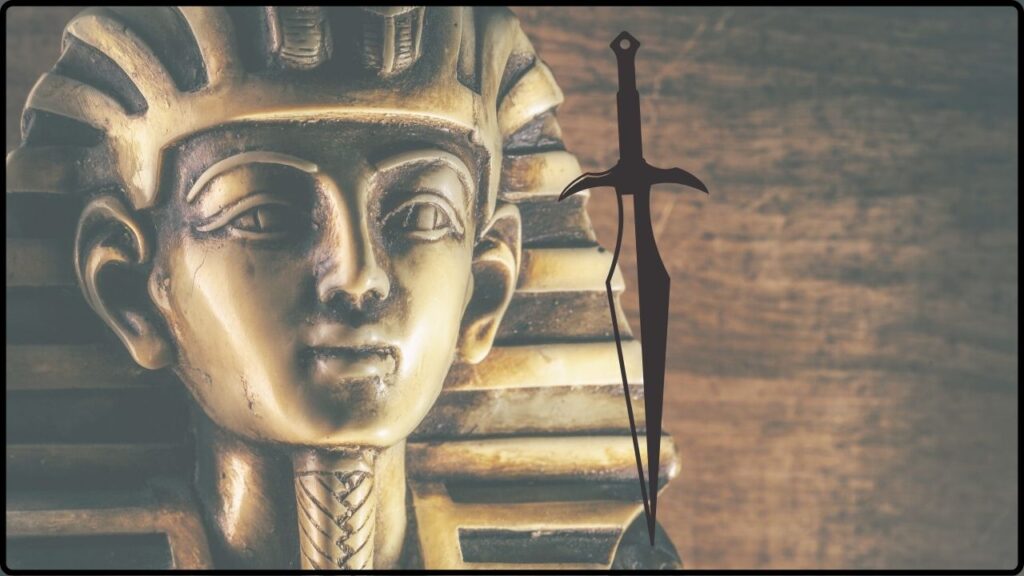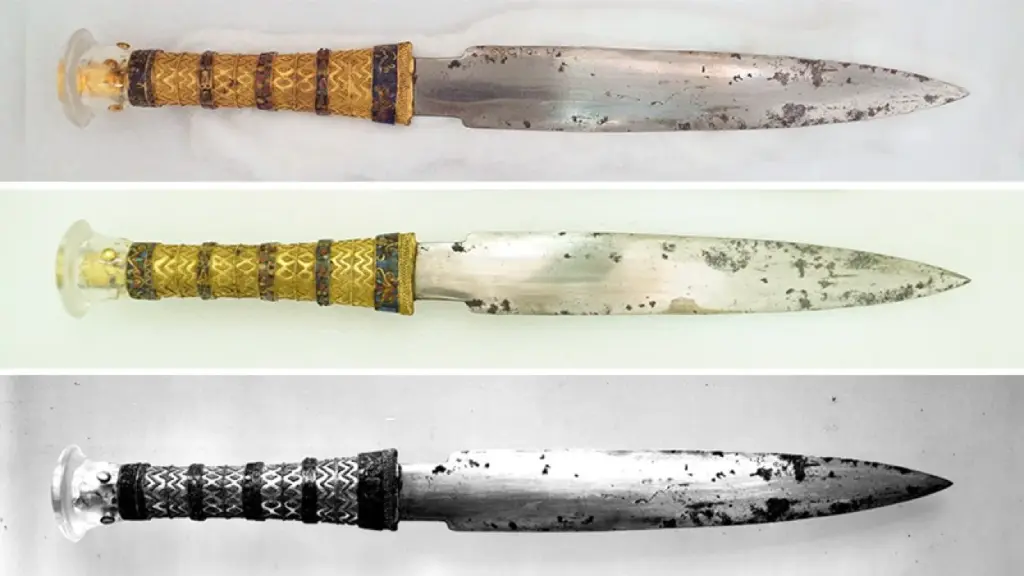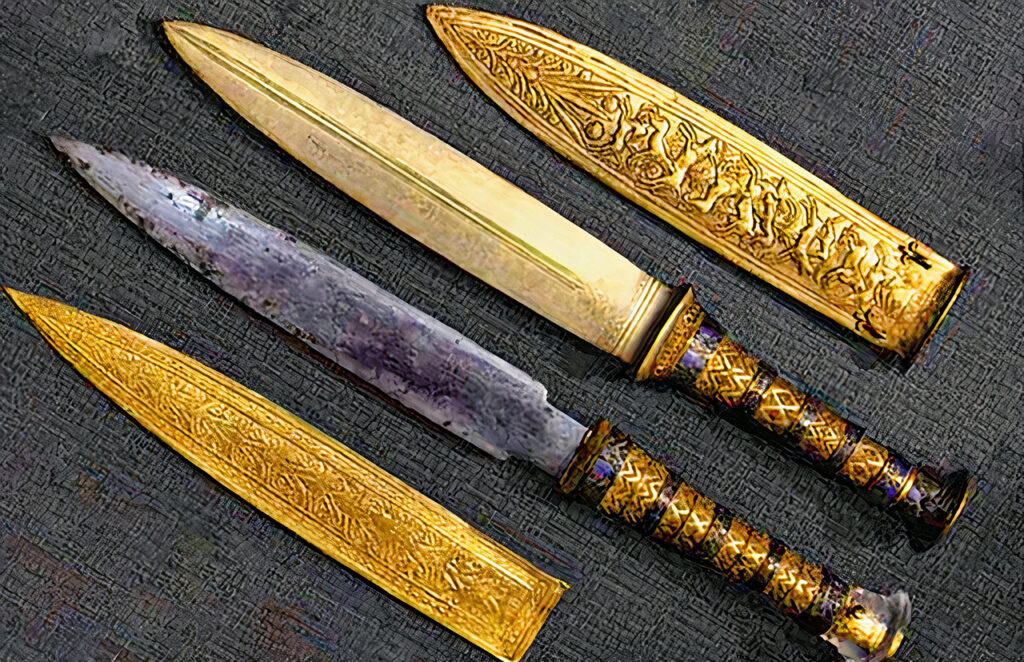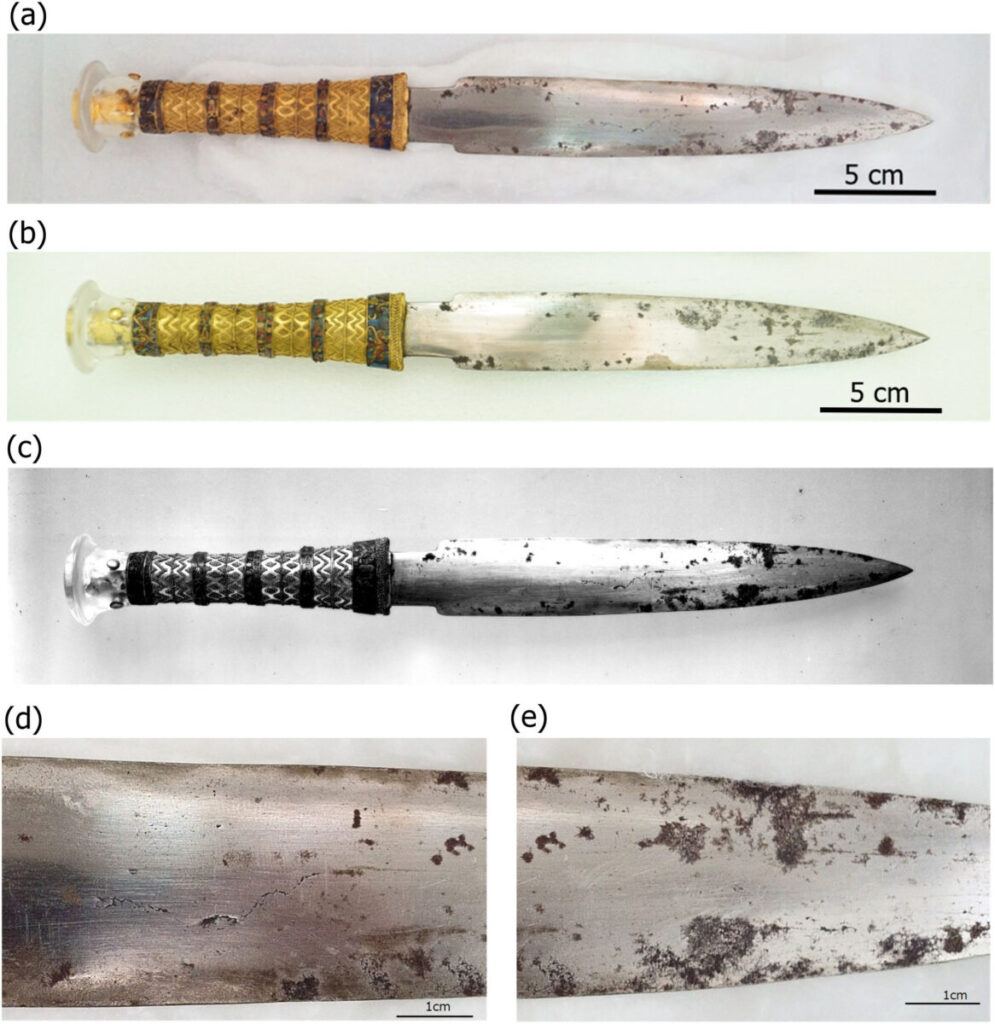
Tutankhamun’s ‘Sky Dagger’ Mystery: Tutankhamun’s Sky Dagger, the ornate and mysterious weapon discovered in the tomb of the famous boy pharaoh, has fascinated archaeologists and scientists for over a century. Now, thanks to modern scientific analysis, the enigma has finally been solved. The dagger was forged from meteoritic iron, meaning it came not from the Earth—but from outer space. This discovery not only answers one of Egyptology’s oldest questions but also highlights the early Egyptians’ surprisingly advanced understanding and use of exotic materials long before the advent of iron smelting.
Tutankhamun’s ‘Sky Dagger’ Mystery
The solution to the mystery of Tutankhamun’s Sky Dagger is nothing short of extraordinary. Forged from a meteorite and refined into a blade fit for a god-king, the dagger is a tangible link between the cosmos and human culture. It reminds us that even ancient civilizations—without modern tools or theories—recognized the power and mystery of the universe. From the sands of Egypt to the stars above, this single artifact tells a story of science, spirituality, diplomacy, and artistry. It’s a timeless lesson in curiosity, craftsmanship, and our shared connection to the cosmos.
| Aspect | Detail / Statistic | Professional Insight |
|---|---|---|
| Material | ~11% nickel, 0.6% cobalt (XRF-tested) | Matches typical iron meteorite composition |
| Date | 14th century BCE | Egypt’s Bronze Age—pre‑iron smelting era |
| Origin | Meteorite iron (a.k.a. “iron of the sky”) | Revered as a divine material |
| Artifact Style | Gold hilt, floral motif, rock crystal pommel | Royal, ceremonial—not functional |
| Cultural Importance | Symbolized divine power & celestial authority | Used for ritual, not combat |
| Other Examples | Gerzeh beads (~3200 BCE), Inuit knives, Mesopotamian ornaments | Meteorite iron use was global |
The Dagger That Fell From the Sky
The Sky Dagger was discovered in 1922 by British archaeologist Howard Carter, resting beside Tutankhamun’s mummy in his sealed tomb in the Valley of the Kings. While most artifacts from the era were made of bronze, wood, or gold, the dagger immediately stood out for its metallic blade, which didn’t rust and had a silvery sheen.
Given that large-scale iron smelting didn’t emerge in Egypt until about 600 years later, the dagger’s composition presented a mystery that took nearly a century to unravel.
The solution came with X-ray fluorescence (XRF) spectrometry, a non-invasive technique that analyzes the elemental makeup of materials. A 2016 study led by researchers from Politecnico di Milano and the Egyptian Museum revealed that the blade contained:
- 11% nickel
- 0.6% cobalt
- Trace elements in ratios nearly identical to those found in iron meteorites
This combination is not common in Earth-based smelted iron but is typical in iron meteorites, which are remnants of planetary cores from asteroids or protoplanets that broke apart billions of years ago.

The Meaning of “Iron of the Sky”
To the ancient Egyptians, iron from meteorites was known as “ba-en-pet”, which translates to “metal from the sky”. This term reflects their celestial interpretation of the material’s origin. Unlike smelted iron, which would become widespread only in the first millennium BCE, meteoritic iron could be worked through cold hammering, avoiding the need for high-temperature furnaces.
This otherworldly origin made meteoritic iron symbolically powerful, imbued with divine energy. In a society where the Pharaoh was viewed as a god on Earth, owning or being buried with an item from the heavens was more than a status symbol—it was a spiritual connection.
The Sky Dagger’s exquisite design—with a gold hilt adorned in intricate floral patterns, a pommel made from rock crystal, and fine cloisonné inlays—reinforces the idea that it was ceremonial, not meant for combat. Its function was to display power, divinity, and cosmic authority.
Diplomatic Origins: A Gift From the Mitanni?
The dagger’s meteoritic material likely arrived in Egypt through diplomatic exchanges. Tutankhamun’s grandfather, Amenhotep III, received several gifts of iron from the Mitanni Kingdom, located in what is now northern Syria and southeastern Turkey. These diplomatic exchanges are documented in the Amarna Letters, a collection of clay tablets detailing political relationships between Egypt and neighboring empires during the 14th century BCE.
One such letter describes a Mitanni king sending iron daggers and jewelry as royal gifts. While we cannot prove definitively that the Sky Dagger was one of these items, the timing, style, and origin of the metal make it a plausible and likely scenario. If true, this would mean the dagger is also a relic of early international relations, providing insight into how prestige goods circulated among elite rulers.
Tutankhamun’s ‘Sky Dagger’ Mystery: Meteorite Iron Around the World
Tutankhamun’s dagger is one of the most famous artifacts made from meteoritic iron, but it’s not alone. Several other ancient civilizations also used this rare celestial material:
- Gerzeh Beads (Egypt, ~3200 BCE): Considered the earliest known use of meteoritic iron, these tiny iron beads were hammered into shape and predate Tutankhamun’s dagger by nearly 2,000 years.
- Inuit Knives (Greenland): Indigenous Arctic communities used the Cape York meteorite, one of the largest known, to craft tools for generations.
- Mesopotamian Iron Artifacts: Various burial sites in Mesopotamia have revealed meteoritic iron ornaments and daggers, typically reserved for royalty or high-ranking officials.
These examples prove that across cultures and continents, ancient people recognized the uniqueness of meteoritic iron and sought to turn it into items of prestige and spiritual importance.

Craftsmanship Beyond Their Time
The Sky Dagger isn’t just famous for its cosmic origin; it’s also a masterpiece of metallurgy. The artisans who made it didn’t melt the metal—instead, they likely used cold-working techniques such as hammering and grinding to shape the blade.
What makes this even more remarkable is that meteoritic iron is high in nickel, making it harder and more brittle than smelted iron. Working it requires expertise and patience—and the level of polish and sharpness achieved on Tut’s dagger blade shows that Egyptian craftsmen had a far more sophisticated grasp of metalwork than previously believed.
The decorative flourishes, including gold sheet overlay, a crystal knob, and exquisite workmanship, suggest that the dagger was meant to be both a technological wonder and a religious object. Its presence in Tutankhamun’s tomb underscores the belief that the pharaoh would continue his rule in the afterlife—and needed a weapon worthy of a divine being.

Educational and Scientific Impacts
This discovery has implications far beyond Egyptology. Here’s why professionals across multiple fields should care:
For Scientists
The study exemplifies how non-destructive technologies, like XRF, can be applied to ancient materials without compromising their integrity. It’s a case study in how science and archaeology work together to solve historical mysteries.
For Historians
It enriches our understanding of Bronze Age trade, diplomacy, and technological capabilities, painting a more connected and innovative picture of early civilizations.
For Educators
The dagger’s story combines astronomy, history, science, and art into one compelling narrative—perfect for engaging students of all ages. What kid wouldn’t be fascinated by a blade from outer space?
For Museums and Curators
Understanding the composition of objects allows for better preservation, cataloging, and storytelling. It also raises the bar for verifying artifact provenance using cutting-edge tools.
Not Gold, Not Copper—Egyptians Used Iron From Space in Sacred Objects, New Study Reveals
This Discovery Changes Everything—Scientists Find Cobalt Can Be Harvested from Urine
Not Gold, Not Platinum—This Man’s Mysterious Rock Was Worth More Than Both and Came from Space











